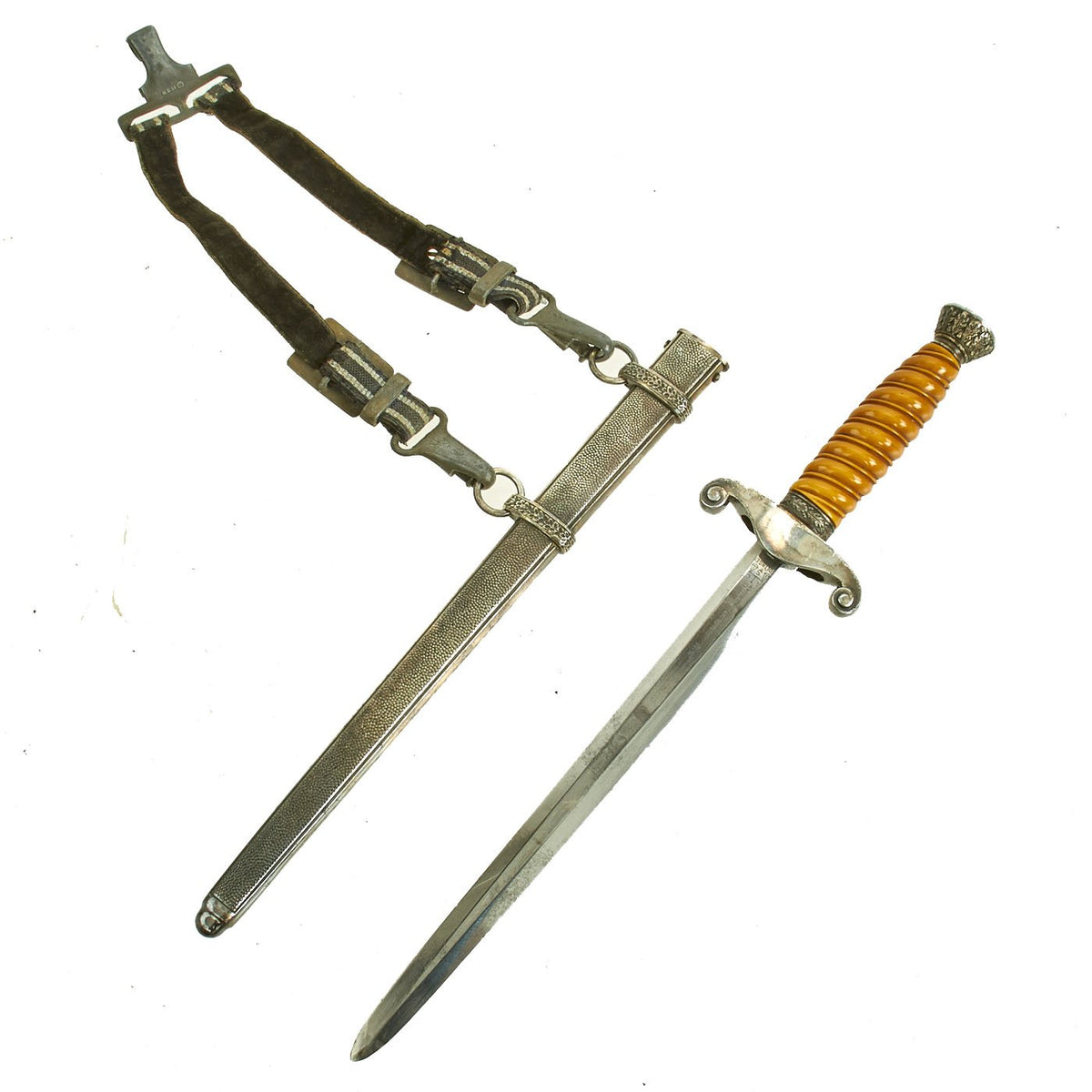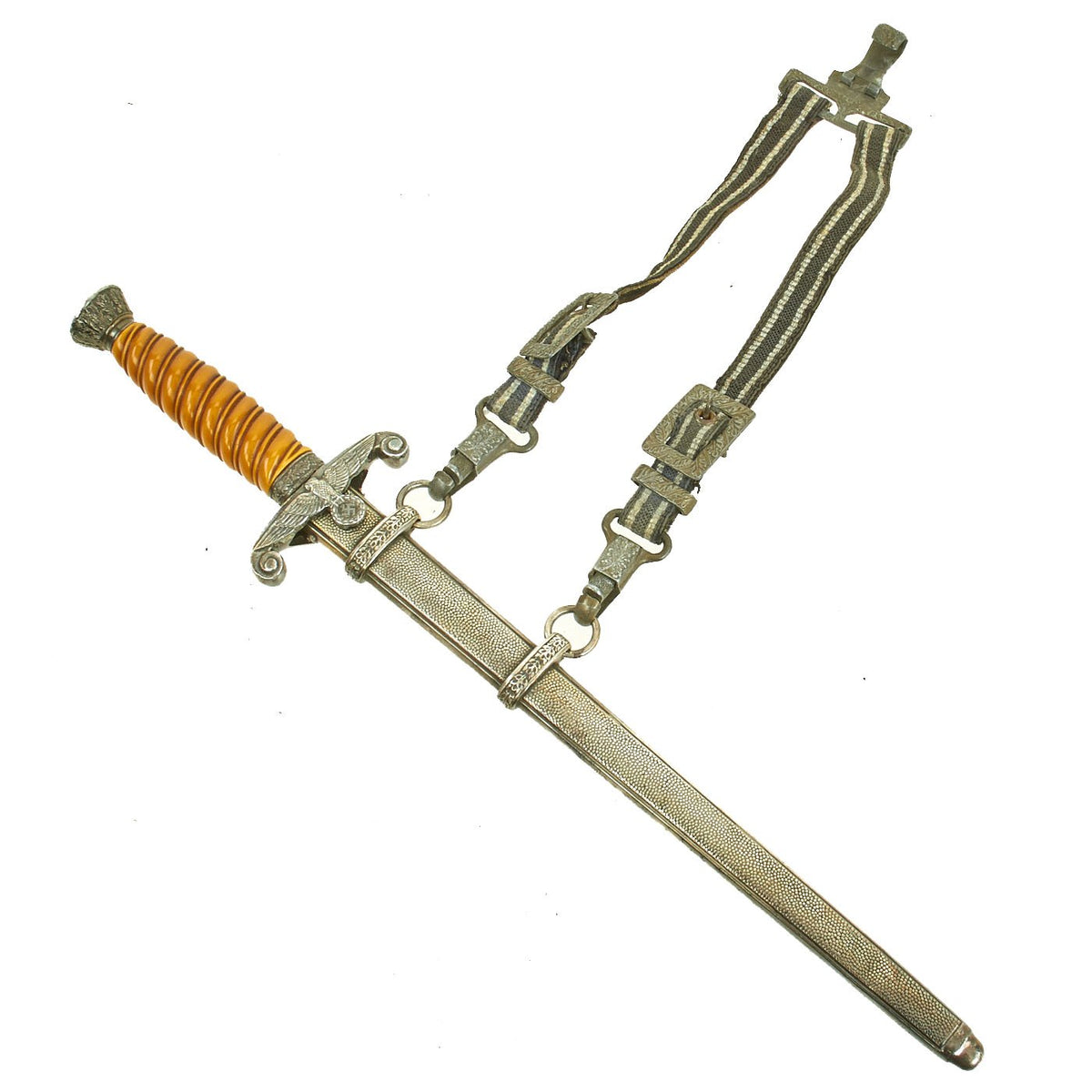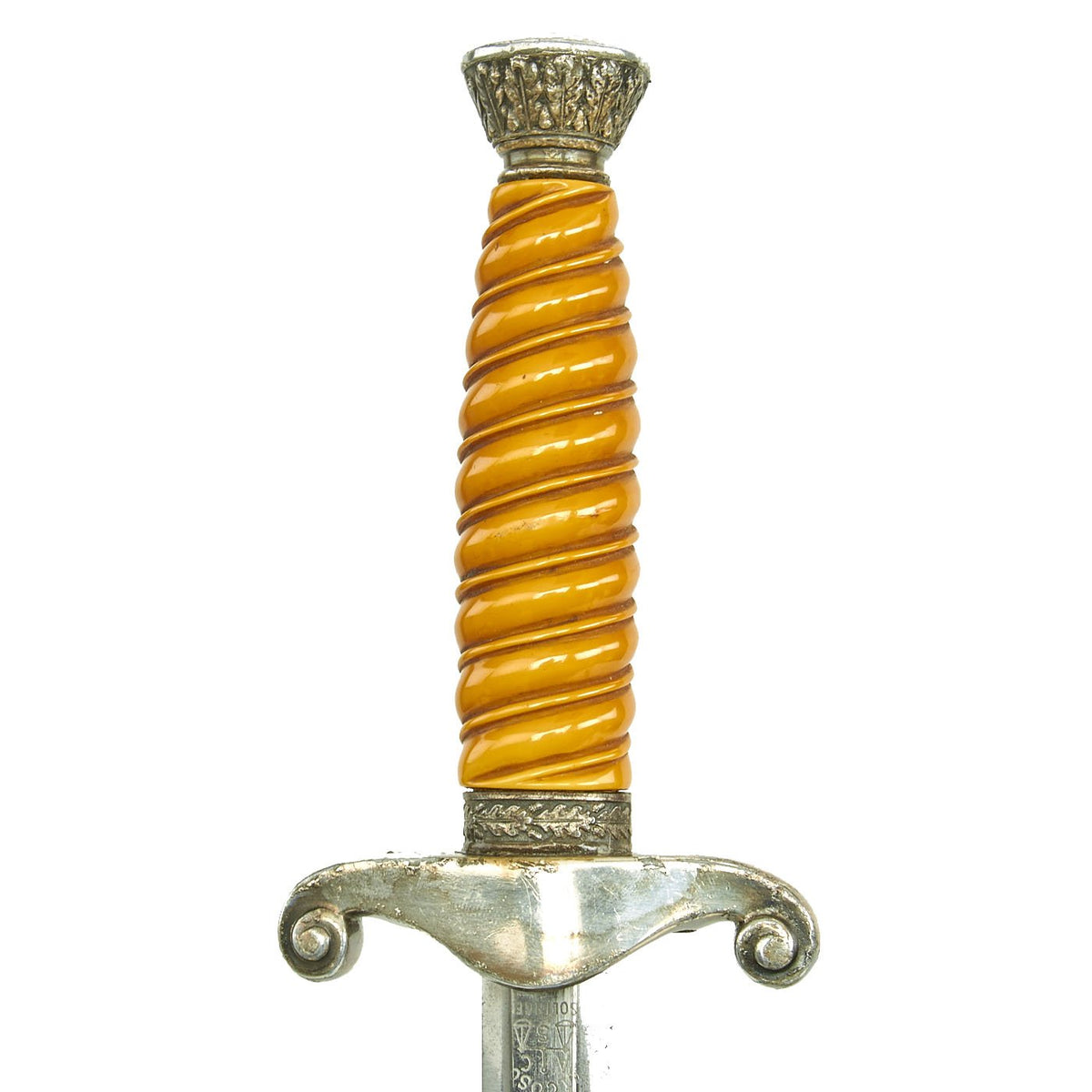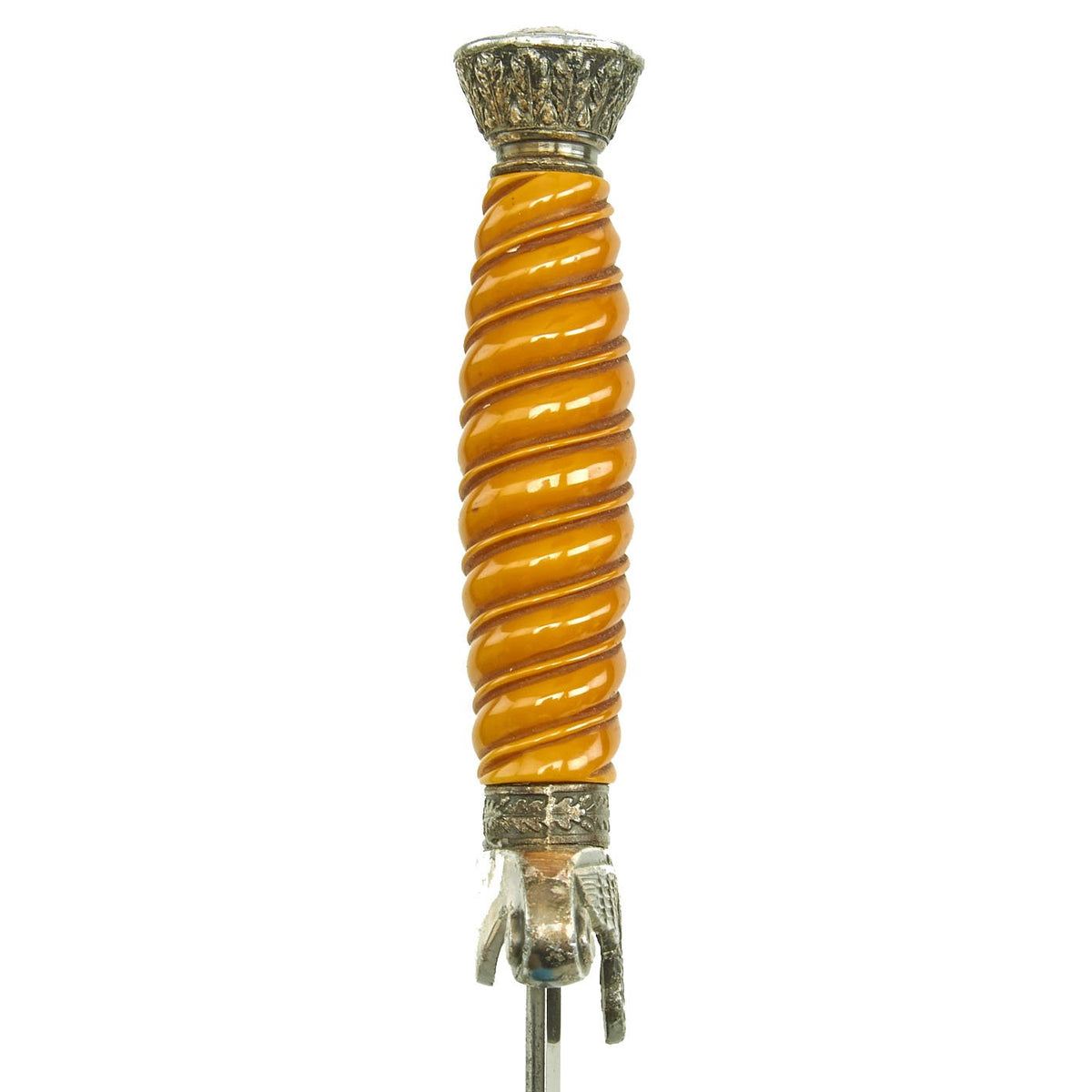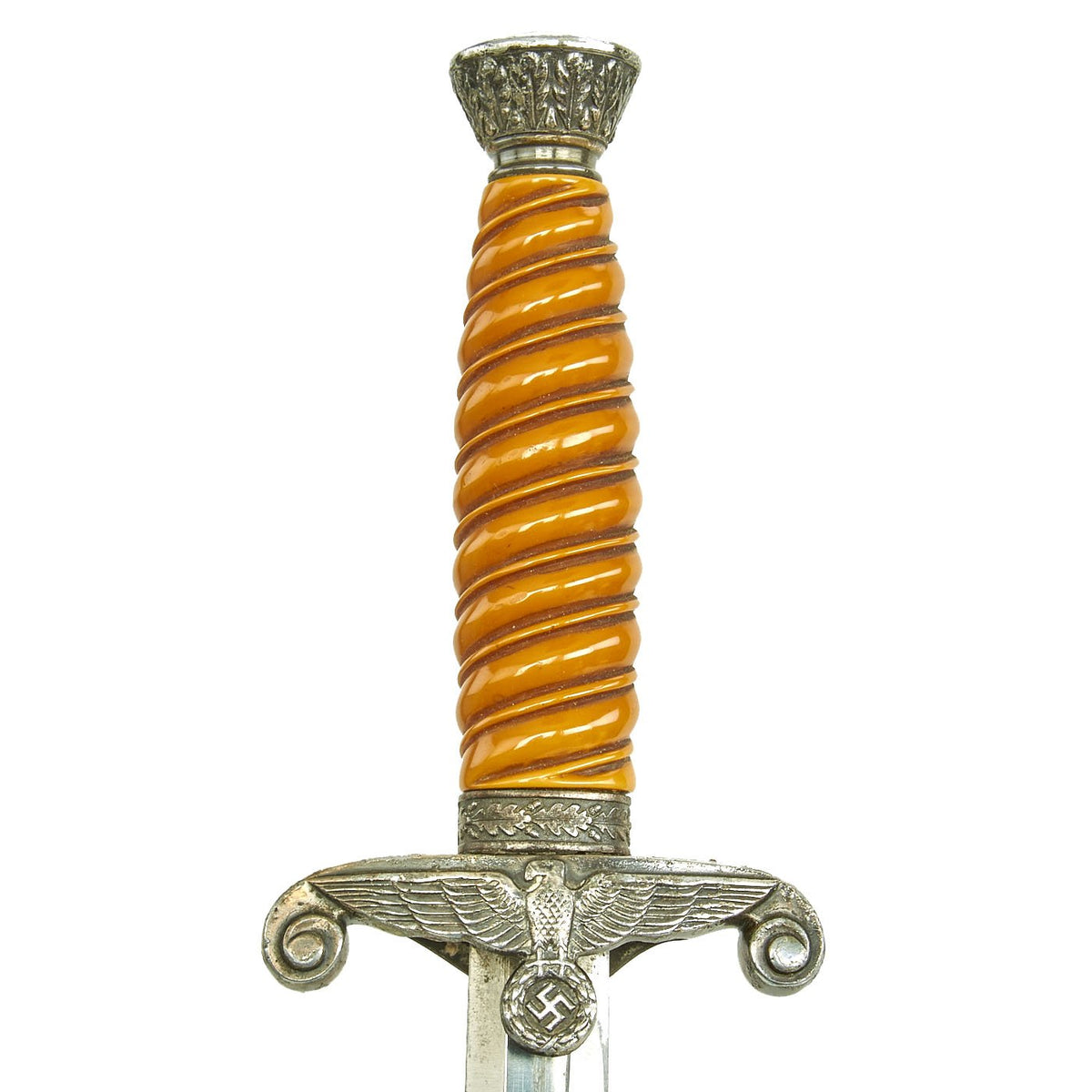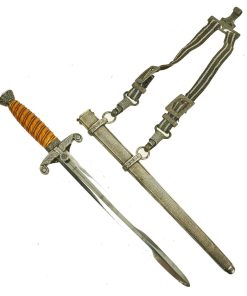Original German WWII Army Heer Officer Dagger by Alcoso with Hanger circa 1940 Original Items
$ 595,00 $ 178,50
Original Item: Only One Available. This is a very nice circa 1940 example of the typical German WWII Army Officer dagger with a belt hanger, made by the Solingen-based firm of Alcoso-Werk GmbH. The pommel of this dagger is in good condition, showing a bit of wear around the rim, and some bubbling under the silver plating due to corrosion of the nickel alloy base metal. The standing oak leaves and acorns on the sides are crisply detailed and have good black backgrounds.
The crossguard also shows much of the original silver plating, and the rest has worn through to the base metal. The details throughout the eagle are good throughout the head, breast and wing feathering, talons and wreathed mobile swas, though there is wear in areas, so the details are not as sharp as they once were.
The celluloid grips of these daggers often these turn orange over the years, just as this one has, however there is no cracking, and it has a nice light pumpkin color. This grip is in good condition throughout, with just a few small scratches. The ferrule is intact, and in very good shape, with the expected oxidation.
The carbon steel blade is in very good condition, however it has been sharpened, and the tip reshaped due to damage, as shown. These daggers were for ceremonial use, and were never really intended to be sharpened. There are some nicks on the edge, as well as runner wear, though some factory crossgrain is still visible in places. The leather blade washer is still intact and in place inside the crossguard.
The reverse ricasso is etched with the trademark Alcoso used in 1939-1940. It depicts the scales with the firm’s initials, ACS interspersed. Above is the firm’s name, Alcoso in script and below the town of business, SOLINGEN, the legendary “City of Blades” in Western Germany.
Alcoso was originally a trade name of Alexander Coppel & Co. KG, Stahlwarenfabrik, located in Solingen, the legendary German “City of Blades.” The company was a major manufacturer of edged weapons and tools from the end of the 19th century up until the WWII period. Unfortunately, as NSDAP-control increased, brothers Carl Gustav and Dr. Alexander Coppel, the Jewish owners of the firm, were forced out. In 1936 the firm had been “Aryanized”, and started using the name ALCOSO to hide the Jewish family name. By the end of 1936 the brothers were ejected from their Solingen offices, and by 1940 the brand trademark initials ACS were changed to AWS to reflect the change in ownership and name: Alexander Coppel Solingen to Alcoso-Werk Solingen. Carl Gustav Coppel committed suicide in Solingen in 1941, and Dr. Alexander Coppel was arrested in 1942 and sent to Theresienstadt Prison camp, where he died August 5th 1942. For more information please see J. Anthony Carter’s book, GERMAN KNIFE AND SWORD MAKERS.
The scabbard is a fine silver-plated steel example, with a great patina and almost all of original plating intact. There are a few dents on the last 2 inches of the scabbard, but they do not interfere with sheathing the blade. The plating is well retained, and is bright in many areas. The sides have very crisp, finely pebble-grained panels. The alloy carrying bands have an excellent pattern of overlapping oak leaves and acorns, with hand enhancing evident on each of the leaves. The throat is the narrow style, retained by screws on the narrow sides of the scabbard.
Attached to the scabbard is a very good condition belt hanger, with functional pebbled spring clips for the scabbard, though the belt clip end is incomplete and missing the catch. The scabbard end clips are the more complex and desirable sliding type. The buckles and keepers are engraved with the same oak and acorn motif seen throughout the dagger. The hardware is marked D.R.G.M, indicating that these were registered in the German trademark office. The end clip is also marked on the back with RZM and maker code U.E. 10.. “U.E” indicates Uniformeffekten Erlaubnißschein, (Uniform Accessories Licence), and the manufacturer’s numerical code, “10”. It appears the combined RZM/U.E., markings were utilized circa May 1933 to March 1935. These were used when the RZM was still being officially organized. There is unfortunately no listing of the early RZM makers. The straps still have a lot of the velvet backing, and the fittings are all in good shape, except for the belt clip. There is some light oxidation, but nothing major.
Overall a great example of a German Heer Officer’s Dagger with hanger, from a maker with a somber back story.
The German Army (Heer) first carried a dagger beginning in 1935. The weapon was worn in lieu of occasions not demanding the wearing of a more formal sword. The dagger design was quite attractive featuring silvered heavy fittings with white or colored grip. The crossguard depicted a Wehrmacht open-winged eagle clutching a wreathed swas.
The pommel depicted oak leafing around the outer circumference. The scabbard had panels of pebble designs. Later produced examples were plated with nickel, and late war-made pieces were unplated, finished in a gray color metal. This early war version is quite nice, and in great shape.
Specifications:
Blade Length: 9 1/2″
Blade Style: Spear Point Dagger
Overall length: 14“
Crossguard: 2 3/4”
Scabbard Length: 11 1/8″
Fast Shipping with Professional Packaging
Thanks to our longstanding association with UPS FedEx DHL, and other major international carriers, we are able to provide a range of shipping options. Our warehouse staff is expertly trained and will wrap your products according to our exact and precise specifications. Prior to shipping, your goods will be thoroughly examined and securely secured. We ship to thousands clients each day across multiple countries. This shows how we're dedicated to be the largest retailer on the internet. Warehouses and distribution centres can be located throughout Europe as well as the USA.
Note: Orders with more than one item will be assigned a processing date depending on the item.
Before shipping before shipping, we'll conduct a thorough inspection of the items you have ordered. Today, the majority of orders will be delivered within 48 hours. The delivery time will be between 3-7 days.
Returns
The stock is dynamic and we cannot completely manage it because multiple stakeholders are involved, including our factory and warehouse. So the actual stock may alter at any time. It's possible that you may not receive your order once the order has been made.
Our policy is valid for a period of 30 days. If you don't receive the product within 30 days, we are not able to issue a refund or an exchange.
You can only return an item if it is unused and in the same state as the day you received it. You must have the item in its original packaging.
Related products
Uncategorized
Uncategorized
Uncategorized
Armoured Fighting Vehicles of the World: AFVs of World War One (Hardcover Book) New Made Items
Uncategorized
Uncategorized
Uncategorized
Uncategorized
Uncategorized
Australian WWII Owen MK1 Machine Carbine SMG Custom Fabricated Replica with Sling Original Items
Uncategorized
Uncategorized
Uncategorized
Uncategorized
Uncategorized
Uncategorized
Uncategorized
Uncategorized
Uncategorized

